Martial Arts: Korean Arts: Taekwondo
Storming the Fortress: A History of Taekwondo
Part Four:The First Korean Schools: The Maverick Schools
By Eric Madis
Previous articles in the series “Storming the Fortress—A History of Taekwondo” have discussed five early Korean karate schools, four of which were part of the original five schools, known collectively as “Oh Geh Ki Kwan” (Hwang, 1995: 21). All five of the previously discussed schools were led by individuals who had studied karate in Japan under Okinawan instructors, and all of whom had earned ranks of at least first degree black belt (Japanese: shodan; Korean: chodan) while in Japan.
Many other institutes (Korean: kwan; Japanese: kan) of Korean karate were established from 1953 through 1971, and the leaders of most of these schools were senior students of the first Korean karate schools. The leaders of many of these schools participated regularly in discussions regarding cooperation, unification and the establishment of standards between kwan. However, there were two early schools that were led by individuals who seemed determined to follow their own paths, to become extremely successful, and whose credentials, practices and associations with others in the Korean martial arts community were controversial from the outset.
Stylistically, both of these schools could be considered Shotokan schools: utilizing training methods and forms that are clearly based on Funakoshi’s Shotokan karate. Despite their often-unstable relationships with other Korean karate leaders and political officials, the leaders of both of these two schools would become extremely influential and successful forces in Korean karate. One of these schools, the Moodukkwan, was one of the original Oh Geh Ki Kwan. The other, known as the Ohdokwan, was formed after the Korean War by a South Korean general.
Hwang Kee and the Moodukkwan
Hwang Tae Nam (1914-2002) was born on November 9, 1914 in Jang Dan, in Kyong Ki Province, located in the area now known as the Demilitarized Zone (DMZ) between the two nations of Korea. His father, Hwang Yong Hwan, was a recognized scholar during the reign of King Ko Jang, the Yi Dynasty monarch from 1864 to 1907 (Hwang, 1995, 8). Hwang later was called “Kee.” Hwang had an interest in martial arts from an early age, particularly the old Korean foot-fighting sport of taekyon (Hwang, 1995: 9-10).
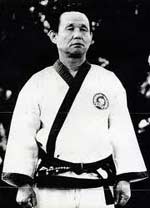 |
Hwang Kee, founder of the Moodukkwan |
Like other Koreans of his generation, Hwang entered elementary school at the age of 11 (1926) and graduated from secondary school in May 1935. Hwang then worked for the South Manchurian Railway (SMR) from May 1935 until August 1937 (Hwang, 1995: 10, 14). He was based during this period of at the main SMR railroad station in Chaoyang (Korean: “Jo Yang”) (Hwang, 1995: 12). Chaoyang is a city located about 250 miles northeast of Beijing in Liaoning Province, in a region of northeastern China traditionally called Manchuria (“Land of the Manchu”). From 1932 until 1945, it was the Japanese-controlled nation of Manchukuo, under the ceremonial leadership of Henry Pu Yi.
In his 1995 book The History of Moodukkwan, Hwang wrote that he studied quanfawith a Chinese instructor named Yang Kuk Jin from May 1936 until August 1937. Hwang wrote that he trained with four other students, and that he and his friend (fellow SMR employee) Park, Hyo-pil trained every other day, due to their work schedules (Hwang, 1995: 12-14). Hwang stated specifically that the training with Yang consisted of the well-known northern Shaolin exercise set known as tam tui(Chinese: “springing legs”), the Yang taijiquan (taichichuan; Chinese: “grand ultimate fist”) form, and exercises for conditioning and mastering basics (Hwang, 1995: 14). In a 1990 interview, Hwang stated that he studied “the northern Yang style of kung fu” with Yang (Liedke, 1990). As Hwang described Yang as being around 50 years of age in 1936 (Hwang, 1995: 12), Yang’s birth date would have been in the 1880s. Therefore, he should be, but is not, a recognizable name in the Yang lineage (Draeger and Smith, 1969: 35-39; Robert Smith, personal communication, December 31, 1999; Wile, 1983: x-xx;). Unfortunately, Hwang didn’t provide his instructor’s name in Chinese characters, which would have facilitated the verification of his existence and his place, if any, in the Yang lineage (Robert Smith, personal communication, December 31, 1999).
Hwang went to work in 1939 for the Chosun Railway (renamed the Ministry of Transportation in 1945), where he had access to exercise and lecture rooms, as well as to the company library, which had some karate books. Hwang wrote that, from 1939 to 1945, he studied Okinawan karate books, and indicated that he did learn forms (Japanese: kata; Korean: hyung) from these books (Hwang, 1995: 16, 18). Although Hwang did not specify which books he studied, traditional Moodukkwan forms are very clearly early Funakoshi/Shotokan versions. Some of the patterns, strategy and movements of these forms vary slightly from the older, Okinawan Kobayashi Shorin-ryu forms in a consistently unique manner (Madis, 2003; Thomas, 1988). This is true whether comparing the forms in Funakoshi’s 1922, 1925 and 1935 texts, or watching documentary film footage from the early 1930s showing Funakoshi at Keio University and other universities (Funakoshi, 1973; Funakoshi, 1997; Warrener, 2001). Although a few other early karate books may have been available to Hwang at this time, few offered the adequate descriptions and illustrations seen in Funakoshi’s books, none were as readily available as Funakoshi’s (Noble, 1996b; Graham Noble, personal communication), and none displayed what would later become Moodukkwan forms. In addition, the names of the Moodukkwan forms and the order in which they were taught in the Moodukwan curriculum corresponded with the Shotokan model.
Chungdohwe founder Lee Won-kuk has stated on numerous occasions that Hwang studied at the Chungdohwe (Lee, 1997; Massar and St. Cyrien, 1999, Uesugi, 2000), which is reinforced by the Moodukkwan’s use of Shotokan-based class structure, forms and training methods. In one interview, Lee said that he became acquainted with Hwang while they were both employees of the Ministry of Transportation (then the Chosun Railway) and that Hwang trained under him at the Chungdohwe from 1944-1947. However, Lee stated that Hwang did not earn even an intermediate, pre-black belt rank (Korean: gup; Japanese: kyu) at the Chungdohwe during that entire period, implying that Hwang’s attendance was occasional (Uesugi, 2000).
Hwang was friendly with other instructors from the Chungdohwe (such as Um Un-kyu, Ko Jae-chun, and Hyun Jong-myong), as well as Yun Byung-in of the YMCA Kwonbop bu and (by the late 1940s) Yun Kwei-byung of Yunmookwan and the Jidokwan (Hwang, 1995: 26, 28, 39). He may have furthered his knowledge with any or all of them.
Some sources (Loke, 2000) have suggested that Hwang studied with the future Renbukai and All-Japan Karate-do Federation president Kondo Koichi (1929-1967). This theory was based on Hwang’s limited association with Kondo (Graham Noble, personal communication, September 15, 1998) and Hwang’s mention of Kondo in his books (Hwang, 1995: 40; Hwang, 1978). However, Kondo’s lifelong associate and Renbukai successor Nagashima Toshi-ichi, who was personally acquainted with Hwang, wrote that Kondo did not even begin karate study until 1947 and that he was a student of Yun Kwei-byung at the Kanbukan (Nagashima Toshi-ichi, personal communication, November 19, 1999). Furthermore, Renbukai spokesperson Takaku Koji stated that Kondo and Hwang met through mutual association with Yun for the first time in 1961 (Takaku Koji, personal communication, October 12, 2000).
Some in the Korean martial arts community doubted Hwang’s claim of Chinese quanfa training, based on lack of evidence (Kang and Lee, 1999: Chapter 1, Section 3). Lee Won-kuk stated that Hwang had no (formal) martial arts training prior to his training at the Chungdohwe (Uesugi, 2000). The Moodukkwan’s traditional tangsoodo curriculum was devoid of Chinese training, with the exception of a changquan (“long fist”) form and a Yang taijiquan form, which are only taught to high-ranking masters (Boliard, 1989), and which are not supplemented by any of usual Chinese supplemental training methods, such as push hands or qigong (chi kung; Chinese: “chi mastery”).
When Hwang made his initial attempt to teach martial arts in November 1945, he called his art hwasoodo(Korean: “flower hand art”). In The History of Moodukkwan, Hwang explained that he arrived at his art’s name after a great deal of thought, and that the name referred in part to the emergence, or “blossoming”, of a new, independent Korea (Hwang, 1995: 24). By his own account, he built this art from fifteen months of quanfa study, self-study of taekyon as a youth, and his study of books on Okinawan karate (Hwang, 1995: 9-18).
Hwang made two separate attempts to establish hwasoodo classes at the Ministry of Transportation (his employer) in 1945 and 1946, but in both instances his small group of students resigned within three months. According to Hwang, this was because Koreans at that time lacked appreciation for Chinese-based arts, due to their long colonization and social indoctrination by Japan (Hwang, 1995: 24-26). If these hwasoodo classes are considered the Moodukkwan’s inception, then it was founded on November 9, 1945. If not, then its inception dates to 1947, when Hwang reformed the Moodukkwan and began to teach tangsoodo(Hwang, 1995: 26). However, for the next eight years, Hwang did continue to refer to his art as both tangsoodo and hwasoodo (Hwang, 1995: 29-30).
Hwang took advantage of space made available to him at little or no cost by the Ministry of Transportation, and soon had established many schools along railroad lines. From the standpoint of expenses and expansion, this gave the Moodukkwan an advantage over other kwan (Kang and Lee, 1999: Chapter 1, Section 3). Other kwan leaders complained that the Moodukkwan had fostered its growth through overly generous standards of admission and promotion, and furthermore pointed to numerous cases of disciplinary and behavior problems with Moodukkwan membership (Kang and Lee, 1999: Chapter 2, Section 5). Therefore, despite his considerable leadership, a growing legacy of notable students, and a reputation for upholding martial arts traditions (Kang and Lee, 1999: Chapter 1, Section 3), Hwang often found himself in conflict with the Korean martial arts establishment. Numerous attempts in the 1950s and 1960s to include the Moodukkwan in the growing taekwondo community were unsuccessful.
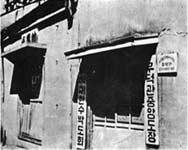 |
Moodukkwan's central dojang in Seoul in mid-1950s |
In 1957, Hwang discovered an ancient book entitled Mooyae Dobo Tongji. An upcoming article in this series will further discuss the Mooyae Dobo Tongji. This book, which was published in the late 1700s, included a portion on unarmed combat, indicating the existence of an organized fighting style named subak. From this point forward, Hwang began to envision a Korean style with the name subakdo, and began to refer to his art as both tangsoodo and subakdo (Hwang, 1995: 37, 42-56).
Hwang formed the Korean Subakdo Association (KSA) in 1960, which would soon include Yun Kwei-byung’s Jidokwan. Because of Yun’s friendship with officials in the All Japan Karate-do Federation (some of whom were his former students), the KSA participated in several tournaments in Japan between 1961 and 1970. Acccording to Hwang, by 1965, 70% of Korea’s martial art practitioners were KSA members, the largest portion being the Moodukkwan (Hwang, 1995: 44). However, in March 1965, a majority of Moodukkwan students, led by Kim Young-taek and Hong Chong-soo, seceded from Hwang’s organization to join the newly formed Korean Taekwondo Association. This was the beginning of a Moodukkwan taekwondo contingent. Eventually, some of Hwang’s notable early students would also form independent tangsoodo organizations.
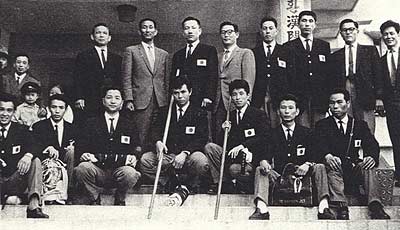 |
1961 Goodwill Tournament in Tokyo. Upper row standing, L to R: Hwang, unknown, Kondo, Yun, Nagashima, three unknown. (Photo courtesy of Nagashima Toshi-ichi.) |
From 1949 until 1995, Hwang Kee wrote and published numerous martial arts books that contained history, instructional information and his technical innovations and theories (Hwang, 1995: 66-67). Hwang remained the leader of the original Moodukkwan and promoter of his newer art of subakdo (a blend of tangsoodo with softer, Chinese martial arts influences) until his death in 2002.
Choi Hong-hi and the Odokwan
Choi Hong-hi (1918-2002) was born November 9, 1918 in Hwa Dae, a village located in Myongchun county, North Hamgyong Province, in what is now North Korea. He began elementary school in 1930, at the age of 11, which was customary for Koreans of that generation. At the age of 15, he was also sent for calligraphy lessons with Han Il-dong, who was said to have also taught the boy the antique Korean kicking and footsweeping sport of taekyon (Gillis, 2008: 20; Kimm, 2000).
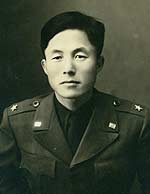 |
General Choi Hong-hi, founder of the Ohdokwan |
Choi’s personal accounts state that he was sent to Kyoto, Japan in 1938 to attend high school (Gillis, 2008: 16, 21-22; Kimm, 2000), after completing the standard eight-year course of elementary and secondary education in Korea. Choi stated that, after watching a karate class at Dong Dai Sa (Japanese: Doshisha) University in Kyoto with his friend Kim Hyun-soo, he began to practice karate (Kimm, 2000). In 1940, Choi relocated to Tokyo to finish high school at a business high school. He then attended Chuo (Japanese: “Central”) University in Tokyo. Choi stated that he studied karate at Chuo University under Shotokan founder Gichin Funakoshi, eventually earning the rank of 2nd degree black belt (Kimm, 2000). By his own account, Choi returned to Korea in 1942 and that he, like other young Korean men, went into hiding to avoid being drafted into the Japanese Imperial Army. However, he was drafted in October 1943 (Kimm, 2000).
Although Choi stated that he “practiced karate” in Kyoto (Kimm, 2000), he did not specify the training or the instructor, nor has his account been verified by witness or documentation. Most martial artists acknowledge their instructors and know their complete name, especially those with whom they studied for several years. Furthermore, they can also elaborate on what their instruction entailed. Any karate instructors (even assistant instructors) teaching in Japan in the 1920s and 1930s were modern karate pioneers, so it is highly unlikely that one would not mention one’s instructor from that period. While there are sources that have stated that Choi studied with an instructor with the surname of “Kim” and that he received his 1st degree black belt from Kim (Choi, 1993: 241-274); Losik, 2003: 99; ITFinfo.com), the only person named Kim that Choi mentioned in later years was the friend with whom he watched a karate class in Kyoto in 1938. There were no Korean instructors under Funakoshi at that time, and no person other than Funakoshi himself had the authority to award any rank to any student of Shotokan karate, much less that of 1st degree black belt.
It should be noted that the only instruction of Shotokan karate that took place in Kyoto was when Funakoshi Gichin (1868-1957) and an assistant would visit the Japanese Imperial Military Academy in Kyoto. Those visits were few, extremely brief and the training very rudimentary. All of Funakoshi’s regular instruction, including that conducted by his assistant instructors, took place in greater Tokyo (Funakoshi, 1935/1973: 10-11; Funakoshi: 1975: 74-75). Goju-ryu karate was being taught in the late 1930s in Kyoto at Doshisha University under the leadership of Shito-ryu founder Kenwa Mabuni (1889-1952) and at Ritsumeikan University under the leadership of Goju-kai founder Yamaguchi Gogen (1909-1989) with his Korean assistant So Nei-chu. However, Choi never mentioned studying with these instructors; always stated that his training was in Shotokan karate, and there is no Goju-ryu influence in Choi’s legacy.
If Choi was in Kyoto from 1938-1940 and at a Tokyo business high school for even a half-year/semester, then the soonest he could have entered Chuo Univcrsity would have been autumn of 1941. If he studied karate from then until the time he returned to Korea in 1942, then he still would have achieved nidan (Japanese: “second degree black belt”; Korean: yidan) with a year or less of training, which is impossible, considering Funakoshi’s standards. At that time, it took even exceptional students two years of regular training to achieve the rank of shodan (Japanese: “first degree black belt”; Korean: chodan), according to Hironishi Genshin, one of Funakoshi’s premier students in the 1930s and 1940s (Takagi, 1989).
Renowned Shotokan instructor and historian Kase Taiji (1929-2004) stated, in an interview conducted by karate historian Graham Noble, that the highest ranking Korean student from that period was one who received a 2nd dan rank and who later returned to Korea, although Kase did not recall the person’s name (Graham Noble, personal communication, July 2000). That individual was very likely Chungdohwe founder Lee Won-kuk, the senior Shotokan practitioner in post WWII Korea and a student of Funakoshi during the 1930s at Chuo University. In a June 2000 interview, Lee stated that Choi studied karate very briefly at Chuo University, that he did not earn even an intermediate rank (Japanese: “kyu”; Korean: “gup”), and that he had no prior martial arts experience (Uesugi, 2000). In addition, several Chungdohwe/Chungdokwan leaders have questioned and denied the extent of Choi’s karate experience (Cook, 2001: 293; Kang and Lee, 1999: Chapter 2, Section 3).
The Military Languages School, which later became the Korean Military Academy, was established by the United States military administration in Korea on December 5, 1945. Its purpose was the training of a new generation of Korean military leaders in the English language and US military doctrine. This school accepted Korean recruits from the Japanese Imperial Army, the Korean Liberation Army and the Manchurian Army. Choi attended this school and became a second lieutenant in the new Republic of Korea (ROK) Army in 1946 (Gillis, 2008: 31). In June 1949, he was sent to the United States for advanced military training at Fort Riley, Kansas and Fort Benning, Georgia. He returned to Korea in June 1950, at the beginning of the Korean War (Kimm, 2000).
In his book A Killing Art, author Alex Gillis discusses Choi’s involvement with the “Pyongyang Incident”, a planned mutinous insurrection by young Korean members of the 30th Division of the Japanese Army. According to this account, Choi and other leaders of this plot were caught and arrested in November 1944. Choi was detained, and later imprisoned under abysmal conditions (that resulted in the deaths of some of his fellow rebels) for the remainder of World War II (Gillis, 2008: 25-29). A 2008 article by Kiriyama Keiichi discusses the 1944 Korean rebellion in further detail. The idea was conceived in May 1944 by a group of Koreans from the 30th Infantry Division who called themselves the “Party of Three Thousand”, a name suggested by Kim Wan-yong, who became the leader of the group. The plot was discovered on October 24, 1944 through a tip from a Korean soldier who was friends with one of the rebels. Twenty-seven members of the rebellion and one civilian were eventually caught, convicted and sentenced, and a number of these individuals died in captivity. Much of the information in Keiichi’s article comes from the testimony of Lieutenant Cheon Sang-hwa, who (like Choi) was sent after World War II to the U.S. to study at an army military school and who later taught at the South Korean Military Academy (Keiichi, 2009). It is curious that Cheon did not mention Choi in his account, because he certainly would have been well acquainted with Choi. However, several interviews conducted by Alex Gillis in 2002 and 2003 with General Lim Sun-ha, who had known and worked with Choi in the ROK military since 1945, reinforce Choi’s claims of his involvement (Gillis, personal communication, July 14, 2011). If Choi’s reported experience with this incident were accurate, then it would certainly explain in part his disaffection with General Park Chung-hee and other Korean military leaders who had been willing participants in the Japanese Army, as well as civilians who had been collaborative with the Japanese.
Chungdohwe founder Lee Won-kuk relocated to Japan in 1950 because of his political problems with ROK President Rhee Syng-man (Lee, 1997; Madis, 2003; Madis, 2010; Massar & St. Cyrien, 1999). This topic was covered in more detail in article one in the present series. At the time Lee left Korea, he asked Choi to act as the temporary chief administrator for the Chungdohwe. Choi accepted the position, soon appointing Chungdohwe senior instructor Son Duk-sung as leader of the school (Kimm, 2000). Son updated the name of the school to Chungdokwan in 1953.
Choi was promoted to the rank of major (2-star) general in 1952 (Gillis, 2008: 31-32). He established the ROK Army’s 29th Division (often called the “Fist Division”) in 1953 (Kimm, 2000). Choi assigned a ROK Army captain and Korean War hero named Nam Tae-hi as the senior tangsoodo instructor with Han Cha-kyo and Ko Jae-chun as assistant instructors. Nam had trained under Lee Won-kuk at the Chungdohwe since February 1946 (Kimm & Nam, June 2003) and had taught tangsoodo at the ROK Army Signal School since 1947 (Kang and Lee, 1999, Chapter 1, Sections 1 & 6). Furthermore, Nam had effectively used his tangsoodo training in hand-to-hand combat in the Korean War (Gillis, 2008: 32-44). Han and Ko were also top senior students at the Chungdohwe (Kimm & Nam, 2003).
In September 1954, the 29th Division performed a demonstration of tangsoodo for ROK President Rhee Syngman. After watching with great interest, Rhee enthusiastically endorsed the instruction of the art to all ROK troops (Kim, 2000). Consequently, in late 1954, a new gymnasium was built for the 29th Division. Choi named this gym the Ohdokwan (Korean: “the institute of my way”), staffing it with more instructors from the Chungdokwan. While Choi would be the leader of the Ohdokwan, Nam Tae-hi would be the instrument by which Choi could implement his ideas. Ultimately Nam’s contributions to the development and teaching of tangsoodo, and consequently Choi’s taekwondo, would be enormous (Gillis, 2008: 32-44; Kang & Lee, 1999: Chapter 1, Section 6; Kimm & Nam, 2003).
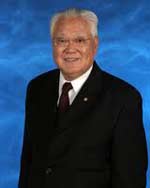 |
Nam Tae-hi, a major contributor to the art of taekwondo. |
Once the process of developing a Korean martial art with the unique name “taekwondo” had begun, Choi devoted his life to the unification of the various schools of Korean karate under that name. He also became a visionary leader of taekwondo, imagining and developing many new techniques with the help of his talented and dedicated followers. (Gillis, 2008: 51-64, 70-76; Kimm & Nam, 2003). Although other kwan developed many of these techniques simultaneously (particularly innovations in kicking), Choi and his assistants catalogued and named many of these techniques. Besides his attempts to establish the Korean Taekwondo Association in 1959, 1962 and 1965, Choi worked with Nam Tae-hi and other Ohdokwan instructors to develop the tul (more commonly called hyung or poomsae, Korean: “forms”; Japanese: kata) of taekwondo (Anslow, 2005; Kimm & Nam, 2003). These forms, specifically referred to as the chang hon forms, were comprised largely of traditional karate techniques and lines of movement, retaining many of the unique strategies and techniques that distinguish Shotokan karate from other karate styles (Funakoshi, 1973; Madis, 2003; Thomas, 1988; Rhee, 1970). This is understandable, since the martial arts foundation of those who assisted in the creation of these forms (all of whom were trained at the Chungdohwe) was Shotokan karate. In any event, these new forms were given nationalistic names, based on famous patriots, generals, monks, philosophers and organizations from Korean history (Yates, 1988; WTF, 2002).
The forces that would propel the evolution of taekwondo from its karate roots were largely political. Choi’s political struggles related to taekwondo, from his coining of the term “taekwondo” in 1954 until his death in 2002, are too numerous to cover in a few paragraphs. An upcoming article in this series will address the major developments of this history, including additional information about Choi and Hwang Kee, who both play pivotal roles in this history.
The Republic of Korea had been an ally of South Vietnam and the United States since the early years of the Vietnam War. Choi had brought members of the Ohdokwan to South Vietnam in 1959 to do a taekwondo demonstration for South Vietnamese President Diem. Between 1962 and 1973, 647 taekwondo instructors were sent to South Vietnam (Kimm, 2000). The art’s reputation would grow from there, resulting in requests for instructors in other countries.
On March 22, 1966 Choi established the International Taekwondo Federation (ITF), forming an association of instructors in nine different countries. By 1969, this organization would have associates in thirty countries (Kimm, 2000). Choi’s influence would continue to grow internationally for another decade, while it would decline at home in Korea. By 1971, political tensions reached a boiling point between Choi and ROK President/dictator Park Chung-hee and Park’s appointed taekwondo leader Kim Un-yong, the first KTA president and assistant director of both the Korean CIA (KCIA) and the Presidential Protection Force. Adding to this difficulty, the philosophical and political distance between Choi and an increasing number of newer-generation Korean taekwondo leaders was growing. Concern about the safety of his family and himself (because of attempted assassinations and kidnappings), as well as his desire to promote his taekwondo from a more politically neutral nation, drove Choi to relocate to Toronto, Canada in 1972 (Gillis, 2008: 103-110; Kimm, 2000).
The ITF had a reported membership of over 20 million in the early 1970s (Anslow, 2005). By the mid-1970s, Choi began to lose many of his once-loyal following, including his most trusted ITF instructors, due in part to increasingly coercive pressure on his instructors at home and abroad by the KCIA and in part to Choi’s autocratic and abusive personality (Anslow, 2005; Gillis, 2008: 2-15, 180-192). These forces, combined with Choi’s decision to promote ITF taekwondo in North Korea in 1980 and his subsequent close relationship with North Korean officials, further alienated many of his staunchest supporters, leaving him with only 10 of his longtime ITF instructors by 1980 (Gillis, 2008: 142-166; Kimm, 2000; Kimm & Nam, 2003).
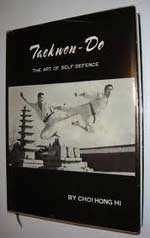 |
NChoi's 1965 book Taekwondo, Korea Art of Self-Defense (in English). |
Despite the cost, Choi’s promotion of taekwondo in North Korea continued. Choi sent Park Jung-tae to Pyongyang for seven months to train North Koreans in February 1982. Some of the trainees are believed to have been former kul sul students of YMCA Kwonbop bu founder Yun Byung-in, who had been abducted by North Koreans in 1950 (McLain, 2009). Forty-four of these trainees were tested and promoted by Choi in September 1982, with 19 receiving fourth dan rank and 25 receiving third dan rank (Kimm, 2000). The growth of the ITF in North Korea furthered the deterioration of his relationship with his longtime ITF followers, even his own son, Choi Jung-hwa (Gillis, 2008: 183-192).
Choi published nine printed works during his lifetime. These included large textbooks on the history, techniques and philosophy of taekwondo (such as Taekwondo: Korean Art of Self-Defense), a fifteen-volume encyclopedia on taekwondo, a brochure on unification of the two Koreas, and even his Moral Guide Book.
Choi succumbed to cancer in Pyongyang, North Korea on June 15, 2002. On the day that he died, he dictated his will, naming Chang Ung (the Olympic representative for North Korean taekwondo) as his ITF successor (Gillis, 2008: 191).
Acknowledgements:
The author would like to personally thank Shannon Burton, Christopher Caile, Alex Gillis, Patrick McCarthy, Dennis McHenry, Toshi-ichi Nagashima, Graham Noble, Robert W. Smith, Michael “Kim” Sol, Joseph Svinth and Kozi Takaku for their personal communications and assistance.
………………………………………………………………………………………………
Next: Part 5 - The Politics of Taekwondo: Patriotism, Nationalism & Personal Ambition
………………………………………………………………………………………………
Bibliography
Anslow, Stuart. (January 2005). Combat: “Grandmaster Kong Young Il”. 34-38.
Choi, Hong-hi. (1993). Taekwon-Do: The Korean Art of Self-Defence, 3rd ed.
Mississauga: International Taekwon-Do Federation.).
Cook, Harry. (2001). Shotokan Karate: A Precise History. Haltwhistle, Northumberland, England: Harry Cook.
Draeger, Donn and Robert W. Smith. (1969). Asian fighting arts. Tokyo: Kodansha International.
Funakoshi Gichin. (1973). Karate-do kyohan. Tokyo: Kodansha International. (Original work published 1935).
Funakoshi Gichin. (1997). To-te jitsu [Karate techniques]. Hamilton, Ontario, Canada: Masters Publication. (Original work published 1922).
Funakoshi Gichin. (1975). Karate-do: My way of life. Tokyo: Kodansha International.
Gillis, Alex. (2008). A Killing Art. ECW Press. 2120 Queen Street East, Suite 200,
Toronto, Ontario, M4E IE2. Canada.
Gillis, Alex. (2011). Personal communication (email) with Eric Madis. July 14, 2011.
Hwang Kee. (1995). The history of Moo Duk Kwan. Springfield, NJ: U.S. Tang Soo Do Moo Duk Kwan Federation.
Hwang Kee. (1978). Tang soo do (soo bahk do). Springfield, NJ: U.S. Tang Soo Do Moo Duk Kwan Federation.
International Taekwondo Federation Information (website). (2011).
http://www.itf-information.com/information02.htm
Kang Won-sik and Lee Kyong-myong. (1999). T’aekowndo Hyondaes (Korean) A
Modern History of Taekwondo (Susan Park/Eric Madis, Trans., 2002).
Kang Won-sik and Lee Kyong-myong. (1999). T’aekowndo Hyondaes (Korean) A
Modern History of Taekwondo (Glenn Uesugi, Trans.)
http://tkd.stanford.edu/documents/tkd_history.pdf
Keiichi, Kiriyama. (2009). “A 1944 Korean Rebellion Within the Japanese Army. The Testimony of Lieutenant Cheon Sanghwa” (Nobuko Adachi, translator). The Asia-Pacific Journal, Vol. 21-4-09, May 25, 2009. (First appeared in Sekai [World] December 2008.)
http://www.japanfocus.org/-Kiriyama-Keiichi/3151
Kimm He-young. (January 2000). “General Choi, Hong Hi: A taekwondo history lesson”, Taekwondo Times (pp. 44-58).
Kimm, He-Young and Nam, Sang-kook. “Grandmaster Nam Tae Hi: From
Chungdokwan to Chicago”, Taekwondo and Korean Martial Arts. June 2003. 38-45.
Lee Kang-seok. (1997, March). Grandmaster Won Kuk Lee, founder of Chung Do Kwan (interview). Taekwondo Times. 44-51.
Liedke, Bob. (1990, May). Korea’s living legend: Tangsoodo-Moodukwan’s Great Grandmaster Hwang Kee (interview). Taekwondo Times. 38-40.
Loke, M. K. (August 2002). A style is born: Re Yi Wu Kwan Tang Sou Dao. (See new
website: http://www.tangsoudao.com/history.htm.)
Losik, Len. (2003). The Kwans of Tang Soo Do: A New Look at Old Traditions. SanLen
Publishing. Aptos, CA. 99.
Madis, Eric. (2003). “The Evolution of Taekwondo from Japanese Karate”. Martial Arts
in the Modern World. Edited by Thomas A. Green and Joseph R. Svinth. Prager Publishers. 88 Post Rd. West, Westport, CT 06881. 185-207.
Massar, Frank and Adrian St. Cyrien. (April 1999). “Won Kuk Lee, An Interview with
the True Founder of Taekwondo.” TKD and Korean Martial Arts (pp. 14-17).
McLain, Robert. (April 2009). “Grandmaster Yoon Byung-In.” Totally Taekwondo, April 2009 (2), 5-11.
Nagashima Toshi-ichi (1999). Personal communication (letter) with Eric
Madis. November 19, 1999.
Noble, Graham. (1996). “The First Karate Books.” Dragon Times (vol. 12). 27, 36.
Noble, Graham. (1998). Personal communication (letter) with Eric Madis.
September 15, 1998
Noble, Graham. (2000). Personal communication (letter) with Eric Madis. July 2000.
Rhee, Jhoon. (1970). Chon-ji of Taekwondo Hyung. Ohara Publications. Burbank, CA.
Smith, Robert W. (1999). Personal communication (letter) with Eric Madis. December 31, 1999.
Takagi, Jotaru. (1989). “Karate-do Impressions: A Roundtable Discussion with Sensei
Hironishi Sensei, Uemura Sensei and Takagi.” Karate-do Magazine (Japanese).
Takaku Koji (2000). Personal communication (letter) with Eric Madis. October 12, 2000.
Thomas, Chris. (October 1998). “Did Karate’s Funakoshi Found Taekwondo?” Black Belt . 26-30.
Uesugi, Glenn. (June 16, 2000). “Spoke to Grandmaster Lee Won Kuk Today”. Posted
on Taekwondo.net.
Warrener, Don. (2000). Gichin Funakoshi: The Original Shotokan Karate. [Videotape]
Masterline Video Productions, 5 Columbia Dr., Suite #108, Niagara Falls, NY 14305-
1275, USA.
Wile, Douglas. Yang Family Secret Transmissions. Brooklyn, NY: Sweet Chi Press,
1 pp. x-xx).
World Taekwondo Federation. (2002b). “About Taekwondo (poomsae).”
http://www.wtf.org/main.htm.
Yates, Keith D. (1982/1988). The Complete Book of Taekwondo Forms. Palladin Press, 7077 Winchester Circle, Boulder, CO 80301.
About The Author:
Eric Madis is a Pacific Northwest recording artist, guitar instructor and Tang Soo Do instructor. He began his martial arts training in 1963 and his study of Korean martial arts in 1982, and holds a master rank in Tang Soo Do. His instructors were pioneers of Tang Soo Do and Tae Kwon Do. Mr. Madis’ previous publications are in the fields of ethnomusicology and martial arts history.
The author would like to personally thank S.Henry Cho, Harvey Kurland, Ron Marchini, Patrick McCarthy, Tom Militello, Toshi-ichi Nagashima, Graham Noble, Robert Smith, Michael “Kim” Sol, Joseph Svinth and Kozi Takaku for their personal communications and assistance.
|